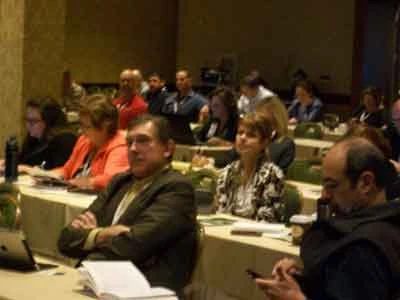
 |
| Stephanie Molloy of the city of San Jose, shares with attendees of the Renewable Energy from Waste Conference how the city overhauled the collection and processing of commercial waste to include processing and energy production from organics. |
The Renewable Energy from Waste Conference, attracted nearly 200 people in San Jose, California, Nov. 17-20, for a preconference workshop, two days of educational sessions, and tours of two of the leading facilities in the country for processing organic waste and producing energy.
The city of San Jose was chosen as the location for the conference because of its approach to integrated waste management that has helped triple the city’s commercial recycling rate and incorporate dry-fermentation anaerobic digestion to generate electricity.
During the session “A city with a vision: how San Jose made waste to energy a reality,” Stephanie Molloy, the city of San Jose’s supervising environmental services specialist for the integrated waste management enforcement and regulations group, explained how the city issued two requests for proposals (RFPs): the first was for commercial waste collection, processing of nonorganics and preprocessing of organics, and the second RFP, was for organics processing and management.
The first contract was awarded to Republic Services, based in Phoenix, and the second was awarded to San Jose-based Zero Waste Energy Development Co.
A panel discussion followed with Carl Mennie, division manager - Recycling and Composting, Republic Services; Emily Hanson, director of business development and communications, GreenWaste Recovery & Zero Waste Energy Development Co.; and Jeff Draper, senior vice president for the dry-fermentation AD technology provider Zero Waste Energy, Lafayette, California.
Attendees had the opportunity to tour the facility where Republic Services processes commercial waste, Newby Island Resource Recovery Park (NIRRP) as well as ZWED to see how material is processed first hand.
NIRRP can process 110 tons per hour of multiple waste streams, including the organic fraction for use in anaerobic digestion. The system in place consists of four processing lines designed to process 400,000 tons per year. This processing system allows the operator Republic Services to sort through wet and dry trash, organics and recyclables to divert as much material as possible from the landfill.
ZWED is considered the one of the first and the largest dry-fermentation anaerobic digestion facilities in the world, capable of processing 90,000 tons per year of material. The company’s fully enclosed facility includes 16 anaerobic digesters and four in-vessel composting tunnels. The biogas extracted from the digestion tunnels are routed to two combined heat and power (CHP) generators to produce electricity and heat with a total generation capacity of 1.6 megawatts.
More information on the REW Conference can be found at www.REWConference.com.
Latest from Waste Today
- Meridian Waste acquires NC hauling firm
- SWANA webinar focuses on Phoenix recycling collaboration
- IntelliShift honored at IoT Breakthrough Awards
- Glass Packaging Institute applauds regulation change
- Paper recycling is focus of 2 January webinars
- Disruption likely for material flows in mid-January
- Florida composting event takes place at worksites
- NC State research could improve predictions for solid waste management





